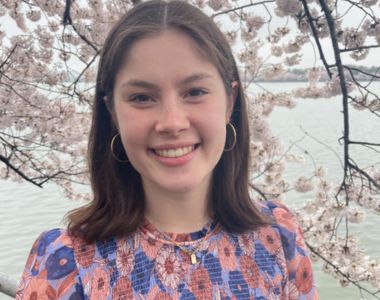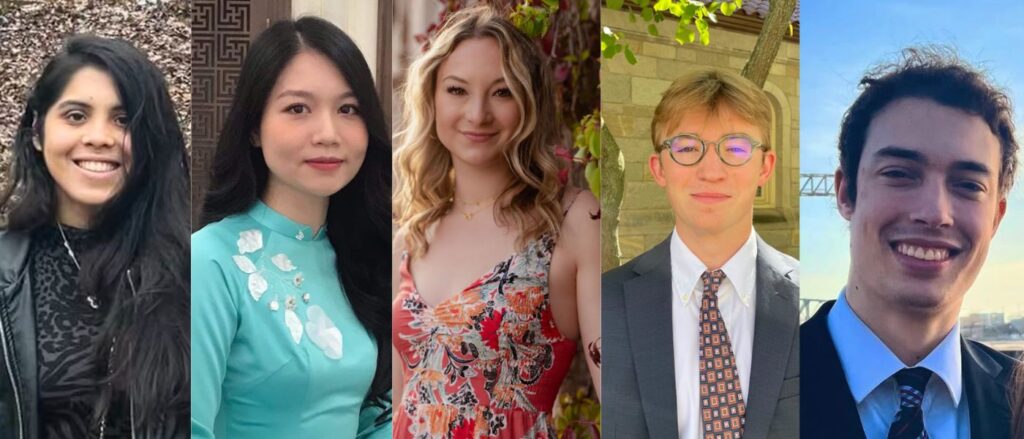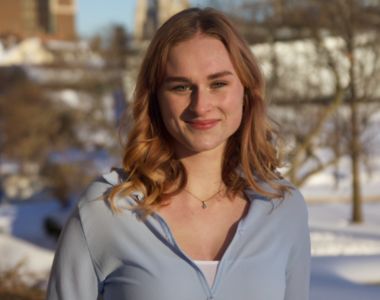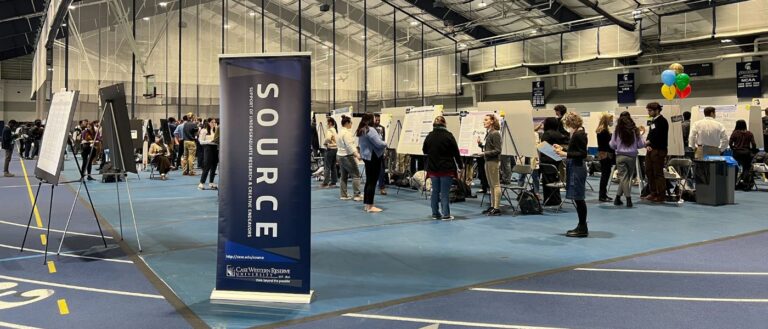Tomorrow (April 21), more than 500 undergraduate students at Case Western Reserve University will take to the Veale Convocation, Recreation and Athletic Center to present their research and creative projects at Intersections, a poster session hosted by the Support of Undergraduate Research and Creative Endeavors (SOURCE) office.
Held each semester, the event is an opportunity for students to share the array of academic work they’re conducting with the academic community, which spans all disciplines—from arts and humanities to engineering, life sciences, physical sciences and social sciences.
To get a glimpse of what attendees can expect, The Daily sat down several students who will be presenting their work. Read on to learn more about their projects—and make a plan to attend Intersections between 11:30 a.m. and 2 p.m. tomorrow.

Katie Merritt
Third-year student majoring in nutrition and economics, with a quantitative methods concentration
1. Tell us about the project you’ll be presenting!
I am presenting my research from the Economics Capstone Course (ECON 395) this semester. My partner, Helen Li, and I are investigating the effect of online food delivery (OFD) apps on consumer food expenditure behavior. We have observed in the data and anecdotally that OFD has become a lot more popular in the U.S. since the onset of the pandemic, and we are interested in how this affects the way people consume food (such as the balance of meals prepared at home versus in a restaurant).
We use consumer food expenditure data by household from the Bureau of Labor Statistics Consumer Expenditure Survey in combination with Google Trends data on the popularity of OFD-related search terms by location over time (such as “doordash”, “grubhub”, and “instacart”). In addition to demographic controls, we control for local-level restaurant restrictions and Covid cases.
So far, we have found that as OFD app popularity increases, people tend to spend less on food away from home (FAFH) relative to food at home (FAH). This result surprised us! We hypothesize the reason for this is that, while individuals may consume more FAFH meals when OFD is popular, they also tend to spend less on OFD meals than they would on a restaurant meal. Think about it: you don’t have to tip as much on OFD, there is little to no alcohol delivery allowed with OFD (depending on where you live), and you are not likely to get a full three-course meal when you’ve ordered online.
2. What did you enjoy most about working on this project? What kind of work went into it?
Economics is a great combination of creative problem solving and critical thinking, and this project has helped me build my confidence in these skills. I have really enjoyed the hands-on application of data skills, empirical research models, and economic theory this project is giving me. There has been a lot of trial-and-error and Googling involved as I learn by doing.
One of the biggest challenges I’ve faced with this project is finding data to address my research question. This is an example of where creativity comes in—we initially went looking for online food delivery order volume data by metro, but we could not find any public-access data sources for this. So, we pivoted to using Google Trends search popularity as a proxy for OFD order volume. Then, there is a lot of work cleaning the data and merging datasets together (for us, we merged four different data sources together). It is satisfying when you finally get everything merged together and ready to run…until you start running your econometric models and realize there are still issues to fix in the data! It’s a very iterative process of trial and error.
3. Have you presented before?
I have not presented at Intersections before, but I have attended to support friends in the past. It is inspiring to see the diverse range of research projects that fill Veale, from engineering to economics, and hear from passionate presenters. I am excited to present for the first time this spring!
4. Why do you believe students should get involved with Intersections?
Intersections is a great way to experience how exciting and rewarding research can be. Even if you do not plan on pursuing a career in academic research, the skills you build developing a project, receiving feedback from professors and peers, and presenting your ideas are invaluable.
5. Anything else you’d like to add?
I will be presenting my research at the Cleveland Federal Reserve Bank’s Economic Scholar Program conference at the beginning of May, along with some other students from the econ capstone course! Intersections will be great preparation for this. I would also like to thank Professor Jenny Hawkins and our capstone course teaching assistants, Becky and Ester, for all their support and encouragement throughout the research process!

Harshita Kumar, Linh Hoang, Michiko Haynie, Michael Sobota, Anthony Giammo
Fourth-year students majoring in biomedical engineering
1. Can you talk about the project you’ll be presenting?
Our project involves designing a device that mitigates fear and stress associated with intravenous procedures by augmenting the visual and tactical experience of the patient receiving the procedure. We propose a wearable device incorporating a view-blocking shield to obstruct the patient’s view from the procedure, while still providing the clinician with visibility.
2. What did you enjoy most about working on this project? What kind of work went into it?
We found it fascinating to observe the entire process of designing a medical device, from brainstorming ideas that meet user needs to creating the architectural framework of the design, and finally building the physical device.
3. Have you presented before?
We were grateful for the chance to present last semester in December as well! It is really amazing to showcase our work and get valuable feedback. Additionally, we found it rewarding to observe the other presentations and learn about their work.
4. Why do you believe students should get involved with Intersections?
We believe that presenting at interdisciplinary events is an extremely valuable learning experience. It provides an excellent opportunity to improve one’s communication and presentation skills, while also gaining experience in designing an effective poster.

Laura Marsland
Fourth-year student majoring in neuroscience with a minor in chemistry
1. Tell us about the project you’ll be presenting!
The project I’ll be presenting on is the gene expression analysis of Pet1 neuron subtype marker genes. To break that down, some of the neurons in the brain use a neurotransmitter called serotonin to communicate with other neurons and elicit biological responses. The Deneris Lab has previously published evidence that this type of neuron contains genetic information that encodes a key transcription factor called Pet1, which regulates whether downstream proteins are expressed.
In my project, I made slides with very thin slices of embryonic brain tissue, and then used a labeling method called Hybridization Chain Reaction (HCR) in-situ hybridization. What that means is that through several steps, fluorescent tags are added to mRNA that specifically codes for the proteins Slc17a8 and Tph2, both regulated by Pet1. The slides can be looked at under a microscope, and the proteins of interest will show up as different colors. The data obtained is intended to validate the neuronal subtypes that the Deneris Lab has been working on, so that the development and functions of serotonergic neurons can be better understood. Greater understanding of these mechanisms may help improve treatments of conditions that may be involved with the serotonin system (i.e. depression & anxiety).
2. What did you enjoy most about working on this project? What kind of work went into it?
When working on this project, I most enjoyed the troubleshooting process. My procedure involves a sequence of complex steps over days, so there’s lots of opportunities for things to go wrong! I was able to try out a lot of different ways to optimize the methodology. While it was pretty daunting and frustrating at times, the iterative process with slight adjustments each time allowed me to engage more deeply with my project.
3. Have you presented before?
I have not presented before! I am a little nervous to do so, but I’m looking forward to a new experience.
4. Why do you believe students should get involved with Intersections?
I think students should be involved in Intersections regardless of their academic background because it is an important skill to be able to explain your project to the attendees as a presenter, but as an attendee I think it’s also a great opportunity to also learn what others are working on. You may find a project or a group that really catches your attention and expands your knowledge!
5. Anything else you’d like to add?
Just a little note: A lot of research is the experience of failing! And while it may not seem that way because the highlights or breakthroughs are more published, it’s important to remember at all levels of your scientific career that failure is so common, and so crucial to developing a curiosity for all the topics we have yet to understand.

